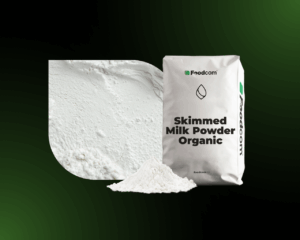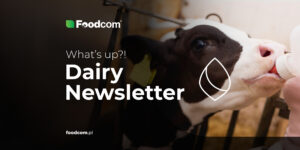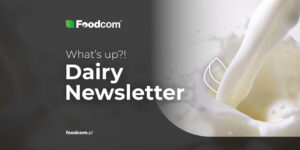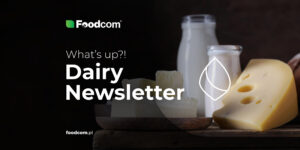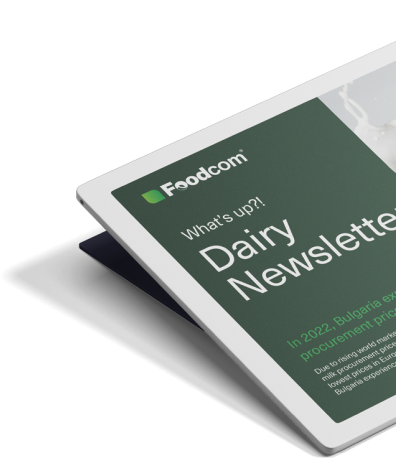- European dairy products are weakening – prices are falling in almost every segment.
- Cheese, butter and cream are becoming cheaper, with only AMF and mozzarella remaining stable.
- Whey is losing ground to protein concentrates – WPC and WPI dominate the market.
- New products on the market: neuroimplants for cows, milking robots, and luxury cheese with ants, priced at tens of thousands of euros per tonne.
Welcome Partners!
Welcome back to our newsletter!
The start of the fourth quarter is not improving the situation in the dairy market. In Europe, oversupply is undermining the market for powders, cheeses and fats, while liquid and whey prices are down for another week in a row. Globally, new trends are emerging – Russia is testing neuroimplants in cows, Canada is betting on robotic cowsheds and Brazil is promoting a luxury cheese with ants. Here’s what’s worth knowing this week.
Scroll down for detailed market data and forecasts.
Milk powder
Skimmed milk powder (SMP) prices in Europe have fallen to €2050-2150/MT. Exports are not improving and rising stocks are reducing the competitiveness of offers. The difference between food and feed powder has blurred, indicating oversupply and weak industry demand.
In Oceania, SMP remains at €2150-2250/MT thanks to steady demand from Asia. Prices there have been stable for several weeks and have not reacted to short-term changes in supply. In the US, quotations are around EUR 2150-2200/MT and are holding their balance after previous declines.
Whole milk powder (FCMP) in Europe is priced at €3750-3850/MT, above the level implied by production costs. Consumption is uneven and demand from the chocolate industry particularly weak. In Oceania, prices are at €3150-3250/MT. The expected increase in supply in the new season could lead to prices falling again.
Cheese
The cheese market in Europe is weakening week by week. Gouda and edam are already priced below €3400/MT and mozzarella is selling at €3250-3350/MT. High stocks are limiting growth opportunities and exports are unable to break the trend.
In terms of demand, mozzarella is doing best, with sales driven by strong demand in the catering industry. Cheddar has no such foothold and in Europe its prices have fallen to €3800-3900/MT, further highlighting the weakness of the sector as a whole.
In the US, cheddar is priced significantly lower than in Europe, which increases its export advantage and facilitates sales in global markets. In Oceania, on the other hand, cheese prices remain stable, with trade focusing on short-term contracts.
Fats
In the European market, butter is currently priced between €6000-6200/MT. High production, additional imports and limited exports are keeping prices closer to the lower ranges. Stocks from the first half of the year are still reaching the market and limiting the potential for price increases.
Lower cream prices are reducing the cost of butter production, but at the same time prompting sellers to accept lower and lower offers to maintain sales. The spot market remains noticeably weakened and further declines can be expected in the near term, although the pace should be milder than before.
For anhydrous milk fat (AMF), the situation is more stable. Quotations are in the range of EUR 6700-6900/MT, and demand from industry and export customers is keeping the balance. Sales are mainly under contract, limiting the risk of surpluses on the spot market.
Liquids
Cream prices in Europeustabilised in the EUR 6000-6200/MT range. Although there was a slight rebound from the previous week, previous declines continue to weigh on butter quotations calculated in cream equivalent.
The price of skimmed milk concentrate (SMC) is in the €1,600-1800/MT range, with lower quality batches selling closer to €1,500/MT and higher protein content achieving rates at the upper end of the range.
The liquid market remains influenced by high raw milk supply and low demand. In the short term, prices are likely to continue their downward trend, with no clear signs of a rapid recovery.
Whey powder
Food whey prices in Europe remain below EUR 1 000/MT and feed whey prices in the range of EUR 800-850/MT. The market is weakened by oversupply and lower exports to China, where imports have fallen by 37%. In this situation, demand is shifting towards protein concentrates, which now dominate trade.
Whey protein concentrate 80% (WPC80) in Europe is stabilising at around €12,000/MT, although production in Germany and France is clearly declining. Growing interest in Q4 contracts and the desire to secure long-term contracts show that demand is sustainable. In the US, WPC80 is priced much lower, around EUR 9000-9300/MT.
Whey protein isolate (WPI) is consolidating the market. In Europe, prices are EUR 19,800-20,500/MT and in the US around EUR 19,000/MT. Lower supply and stable demand are encouraging producers to gradually increase their offers.
In the permeate and lactose market, the downward trend continues. In Europe, permeate prices are around EUR 800/MT and in the USA EUR 480-500/MT. Lactose currently costs EUR 700-750/MT in Europe and EUR 620-640/MT in the USA. The decline in Chinese imports has lowered prices, and additional tariffs on US supplies have diverted some purchases to Europe.
What’s new?
Russia
Russian startup Neiry is testing neuroimplants in dairy cows. The devices send electrical impulses to the brain to regulate hunger and fertility in the cattle. After the operations, the first five animals did not develop any serious complications. However, they are carried out under inhumane conditions – the cow remains conscious throughout the procedure. The system works in an adaptive way. If the appetite drops, the technology runs the appropriate programme to restore normal function. Investors see this as a necessary breakthrough, as traditional ways of boosting performance no longer work. According to the developers, brain stimulation gives an advantage in a competitive market and bypasses genetic constraints. However, activists warn that the cruelty of the procedure raises serious animal welfare concerns. The cost of the apparatus, which is very high, is also a problem. However, Neiry is continuing to research the optimisation of the system.
Canada
Dairy farms in Canada are undergoing a digital revolution thanks to milking robots and systems based on artificial intelligence. New technology is increasing milk production by up to 25 per cent, while reducing labour costs by nearly a third. Automated milking machines operate around the clock, allowing milking to follow a natural rhythm, improving herd health and productivity. Advanced sensors continuously analyse the milk composition and health status of the cows. This allows farmers to detect the first signs of disease more quickly. Smart ventilation systems and renewable energy sources are also being used on many farms, increasing efficiency and reducing bills. Although this investment is not cheap, farmers usually achieve a return within a few years.
Brazil
A cheese with edible ants has been developed in São Paulo and has won awards at prestigious competitions in France and Peru. The product stands out for its original recipe and is presented as an example of Brazilian innovation in the dairy sector. Taiada cheese is made from milk, rennet, salt and roasted ants. It combines the sweet taste of almonds with the crunchiness of the insects for an unforgettable culinary experience. The cheese currently costs around €38,000/MT, more than ten times the price of typical European cheeses. This pricing puts it in the premium luxury segment. The increasing demand for unique high-protein products increases its chances of entering the global market. The producer plans to expand sales and use foreign interest to build the brand. Its past successes show that local traditions can be transformed into a premium product with export potential.
![Europe’s dairy market is losing ground and the world is betting on innovation – from neuroimplants and milking robots to luxury cheese with ants [282nd Edition of DAIRY Bulletin] Europe’s dairy market is losing ground and the world is betting on innovation – from neuroimplants and milking robots to luxury cheese with ants [282nd Edition of DAIRY Bulletin]](https://foodcom.pl/wp-content/uploads/2023/08/Foodcom_SA_Newsletter_Dairy-1520x760.jpg)
